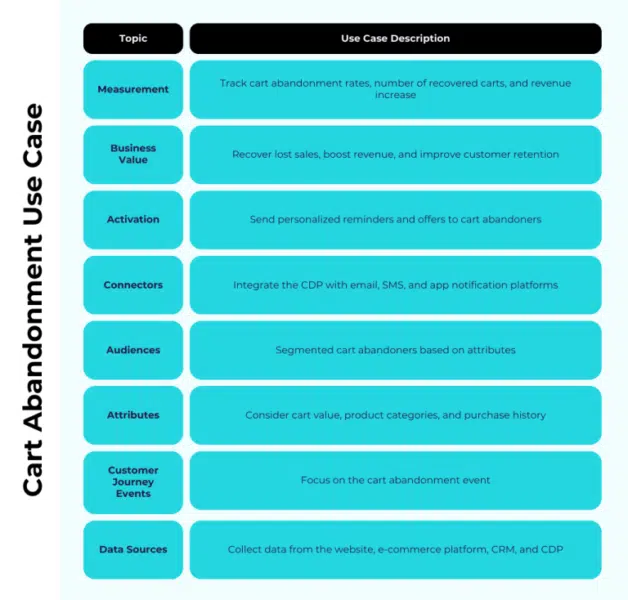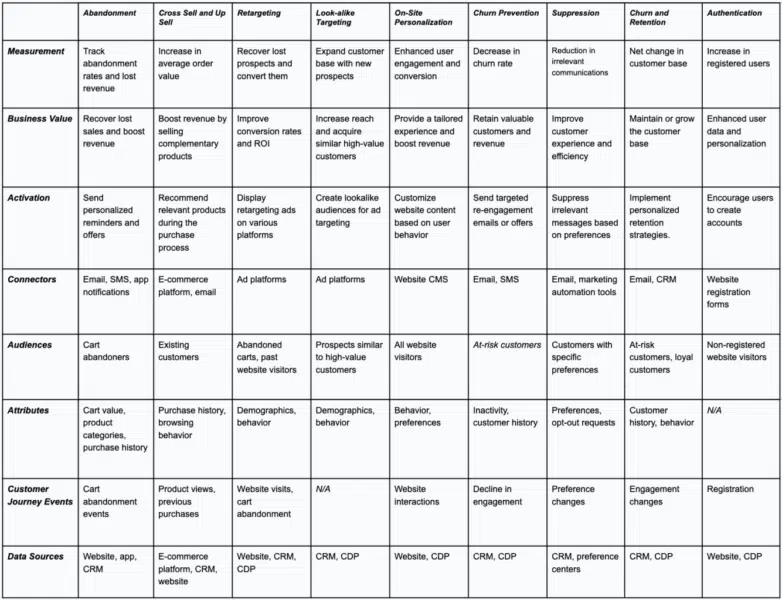Opinions expressed in this article are those of the sponsor. Search Engine Land neither confirms nor disputes any of the conclusions presented below.
How to build a CDP use case
Crawl, Walk, Run: The Iterative Approach for A CDP Use Case

In the ever-evolving landscape of marketing, the use of customer data has become more critical than ever before. Customer data platforms (CDPs) have emerged as a game-changer, enabling businesses to harness the full potential of their customer data. With CDPs, organizations can unlock a wide array of use cases, each catering to specific business needs. This article covers a CDP use case, its benefits and how to implement them effectively for maximum impact.
Crawl, walk, run: The iterative approach for a CDP use case
Before delving into a specific CDP use case, it’s essential to emphasize the importance of the iterative approach. Often, organizations tend to get overwhelmed by the sheer possibilities of a CDP and aim for complex solutions right from the start. Instead, adopting a ‘crawl, walk, run’ approach can be highly beneficial.
To begin, start small – perhaps by addressing a straightforward use case and gradually build upon it. This way, you can understand how the CDP integrates into your existing systems and learn to harness its full potential progressively.
How can you use the ‘crawl, walk, run’ approach?
Cart abandonment is a common CDP use case. Here is an example using the iterative “Crawl, Walk, Run” approach.
- Crawl: Identify customers who abandon their carts and track this data. Measure the cart abandonment rate and its impact on revenue. Start sending basic email reminders to encourage customers to complete their purchases. To activate this data, connect your CDP to your email marketing tool, and the audience would-be cart abandoners.
- Walk: As you gain experience, it’s time to dive deeper into the data. Analyze the customer journey events leading to cart abandonment. Segment your audience based on attributes like cart value, product categories or purchase history. Create personalized email content for different segments. You can also incorporate SMS or app notifications to reach customers through multiple channels. Utilize connectors to automate these processes.
- Run: Now, take cart abandonment prevention to the next level. Implement dynamic on-site personalization for returning cart abandoners. Use returner data to identify and engage customers who have previously abandoned carts. Leverage retargeting campaigns across social media platforms to re-engage cart abandoners. Continuously measure and refine your strategies for optimal results using A/B testing and data analytics.
What is a use case in a CDP?
A use case in a CDP has eight main pillars. Here is how they can add value to your business.
1. Measurement
Defining measurable objectives and key performance indicators (KPIs) is crucial when developing a CDP use case. For instance, in a cart abandonment use case, the measurement could involve tracking the abandonment rate, the number of recovered carts and the increase in revenue.
2. Business value
To determine the business value, you need to identify the direct impact the use case will have on your organization. In the context of cart abandonment, the business value is evident in the form of increased revenue through recovered sales and improved customer retention.
3. Activation
Activation refers to the action you take based on the data and insights provided by the CDP. In a cart abandonment use case, activation involves sending personalized reminders or offers to customers who have abandoned their carts. Activation strategies should be well-defined and designed to achieve the objectives set in the measurement phase.
4. Connectors
Connectors are the bridges that link your CDP with other tools and platforms. In the case of cart abandonment, you would need connectors to integrate your CDP with your email marketing platform, SMS or app notification tools and potentially your ecommerce platform to track and recover abandoned carts effectively.
5. Audiences
Understanding your target audience is crucial. In the context of cart abandonment, the audience would be those customers who have abandoned their shopping carts. These audiences can be further segmented based on attributes and behaviors to tailor messages and offers effectively.
6. Attributes
Attributes are the characteristics or data points that define your audience segments. In the cart abandonment use case, attributes may include the value of the abandoned cart, product categories within the cart, purchase history, and more. These attributes help you personalize your messages and offers.
7. Customer journey events
Customer journey events are specific actions or interactions that customers take along their path to purchase. In cart abandonment, the key event is abandoning a cart. Understanding the customer journey events lets you pinpoint when and why potential customers drop off.
8. Data sources
Data sources are the places where the relevant data is collected. Data sources in the cart abandonment use case include your website, ecommerce platform, customer relationship management (CRM) system and CDP. Data from these sources is used to track customer behavior, gather cart abandonment data, and trigger activation processes. It is important to underscore the need for data quality and consistency from these sources to ensure accurate results.
By considering these elements, you create a comprehensive framework for building a CDP use case that is well-defined, measurable and aligned with your business objectives.
Here is how it all comes together in a framework.

Example use cases associated with definitions
To further examine the use cases, see the below graphic with example-specific definitions.

In conclusion, building a CDP use case involves careful planning. Focusing on measurable objectives, business impact, targeted activation strategies, data integration through connectors, well-defined audience segments, relevant attributes, customer journey events and the data sources that power the entire process is important. When executed effectively, CDP use cases can significantly improve your marketing efforts, customer engagement and overall business outcomes.
Incorporating these CDP use cases into your marketing strategy can substantially improve customer engagement, retention and revenue. Remember, it’s essential to start with simple implementations and gradually progress towards more complex strategies. This approach ensures a smoother transition into the world of CDPs, allowing your organization to fully leverage the power of customer data. So, take the first step and start reaping the benefits of CDPs today. For more resources, explore this blog post, 5 Clever CDP Use Cases You’ll Want To Implement.
Related stories
